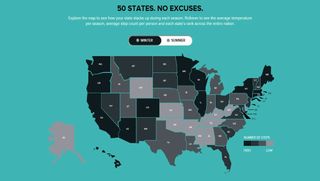
All that running to catch the subway, quick trips to the corner store and treks through the snow add up: On average, people living in New York state log more steps during both summer and winter than people of any other state, according to new data from activity-tracker maker Fitbit.
And despite what may seem like a desire to hunker down and drink hot cocoa when the snow is falling, most people keep their activity levels fairly constant across both seasons, with just a slight dip in activity during winter, the data showed.
"With walking as a primary form of transportation for many of its residents, the Empire State rules all for step-count staying power," the company said on its website.
People in California, Hawaii and Washington, D.C., also stay highly active during the winter months, according to Fitbit.

More and more people are strapping on fitness trackers to log their steps. While some popular guidelines suggest people should walk at least 10,000 steps a day, that's not the official recommendation from the Centers for Disease Control and Prevention. Instead, the CDC says that most people should exercise at moderate levels for at least 150 minutes a week, which translates to about 7,000 to 8,000 steps a day. [The Best Fitness Tracker Brands]
The new data show that many people — at least those motivated enough to use activity trackers — are getting close to that number of steps.
People in the Empire State logged the most steps all year round, walking an average of about 8,800 steps daily in the summer and 7,700 steps daily in the winter, when temperatures average just 25 degrees Fahrenheit (minus 4 degrees C).
Sign up for the Live Science daily newsletter now
Get the world’s most fascinating discoveries delivered straight to your inbox.
Unfazed by cold
Minnesotans don't seem to be fazed by months of frigid weather. They log about 7,500 steps on average during the winter, making the state the fifth-most active during the winter.
But Minnesotans do increase their activity levels in the summer. Perhaps because they're excited to take advantage of the balmy 64 F (18 C) weather, Minnesotans walk an average of nearly 8,700 steps daily during the summer, making their state the second-most active, according to the data. During the summer, Wisconsinites also step up their activity levels, logging about 8,650 steps, bringing that state into the top three.
Meanwhile, people in the South tend to be least active overall, according to the data. Despite miles of gorgeous beaches, Floridians rank lowest in activity in the summer, walking just 7,340 steps a day, on average. In the winter, West Virginians walk an average of just 6,720 steps.
But different methods of sampling and measuring activity across an entire state's population can yield different results. For instance, a Gallup-Healthways poll last year found that the people with the healthiest habits live in Vermont, Montana and Alaska. Those states had the highest number of people who said they ate the recommended amount of veggies and got at least 30 minutes of physical activity three times a week.
In that poll, West Virginia also was ranked as least healthy, with less than half of its residents reporting that they exercised regularly or ate healthy foods.
Follow Tia Ghose on Twitterand Google+. Follow Live Science @livescience, Facebook & Google+. Originally published on Live Science.

Tia is the managing editor and was previously a senior writer for Live Science. Her work has appeared in Scientific American, Wired.com and other outlets. She holds a master's degree in bioengineering from the University of Washington, a graduate certificate in science writing from UC Santa Cruz and a bachelor's degree in mechanical engineering from the University of Texas at Austin. Tia was part of a team at the Milwaukee Journal Sentinel that published the Empty Cradles series on preterm births, which won multiple awards, including the 2012 Casey Medal for Meritorious Journalism.
